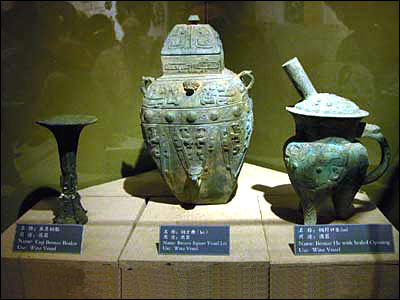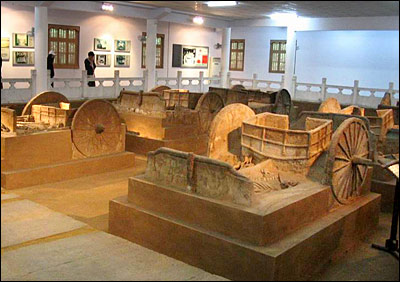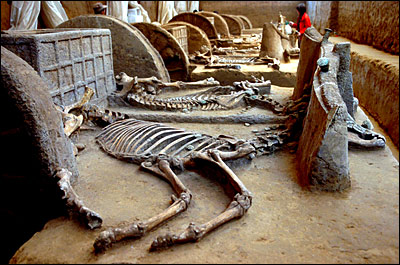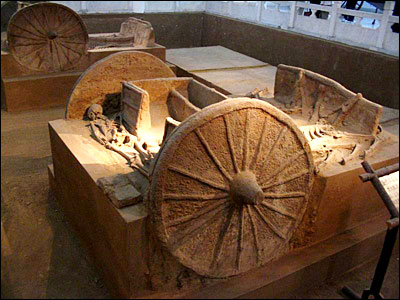| Tools: Save | Print | E-mail | Most Read |
| The Yin Ruins -- Counting the Costs of World Heritage Listing |
| Adjust font size: |
Since July 13, the city of Anyang in central China's Henan Province has been reveling in the joy and excitement of the successful inclusion of the 3,300-year-old Yin Ruins on UNESCO's World Heritage List. The ruins once housed the seat of the Shang Dynasty (1600 BC -1100 BC). But as the euphoria begins to die down, people have been talking about the changes that this World Heritage privilege will bring to this small city, which already sees thousands of tourists passing through every day, all eager to marvel at the grandeur of the ruins. The number one concern seems to be whether the city will be able to balance continued preservation of the ruins with economic benefits.
Making way for the bid As Anyang City basks in the limelight of their successful bid for World Heritage status, there has been talk of a lesser-known village that ought to be given some credit as well. According to a Beijing Youth Daily report on July 26, He Yongxian, an official of Xiaotun Village, the village is actually more famous than the city because a hundred years ago, a scholar named Wang Yirong discovered oracle bones there. The discovery ensured the tiny village's inclusion in primary and middle school textbooks. "The Yin Ruins on the World Heritage list makes the whole village very excited. After all, we have made sacrifices for the bidding. Now it's the time for us to be recognized for our efforts," He said. He reckons that things started to change from April 2001 when Anyang City formally started the bidding process for World Heritage listing. Located in the central area of the ruins, the village and its industries were well within relocation plans. Enterprises were moved out of the village and livestock breeding was stopped. Two thirds of farmland were rented out and 76 households were relocated to the New Area, one kilometer outside of the village. "There are really some conflicts that exist between the protection of cultural relics and the economic development of its neighboring areas. But the reason behind world heritage listing is to give priority to the protection of cultural relics," said Duan Zhenmei, director of the Cultural Relics Bureau of Anyang City. To meet a bid target of 200,000 sq km of "green" land, Anyang demolished 220,000 sq m of houses and buildings in as many as six villages; 692 houses, state-owned and township enterprises and stores were leveled and relocated, and 20 kilometers of river channels and roads renovated. Inhabitants of Huayuanzhuang, another village in the central area of the ruins, can expect to be relocated as well. The success of the bid, however, does not mean an end to environmental works. Anyang has earmarked funds to be used for continued repair and refurbishment until 2010. Their ultimate goal is to build a multi-function archeological site, one that combines a cultural relics exhibition with a holiday resort. "We want to preserve the historical and cultural importance of Xiaotun Village. Its outlook will imitate the building styles of Shang Dynasty. Stores selling tourism merchandise and tea houses will be built," Duan disclosed. Although many of Xiaotun's villagers still aren't quite sure what the future holds for them, they are reaping the short-term economic benefits. Many have opened handicraft stores and annual property rentals have already seen meteoric jumps from 1,000 yuan to anything between 15,000 and 20,000 yuan. Changing landscapes Meanwhile, construction continues in the city, where numerous buildings are slowly changing the look of the east side of the city. What was vast farmland a few years ago is now what is called the Easter Area, the new city center and home to all local government departments, residences for civil servants, widened roads and a large park. Heavy industry can now be found in the southern part of the city, as far as possible from the ruins in the northwest. In and around the ruins, changes are also underway. The once bumpy roads are being resurfaced, trees line the boulevards, a museum -- part of which is underground -- has been built, and even China's national treasure, the four-legged bronze cauldron Simuwu Ding -- the world's biggest bronze ware item ever excavated, has been returned to its hometown from Beijing. The costs of the bid From 2001 to 2006, Anyang spent 230 million yuan (US$29 million) on their bid, not to mention the number of people who were involved in bid preparations. It has been reported that most of that money was spent on demolition and relocation, and other preservation efforts. About 70 percent of the money was provided by the city government, 10 percent from donations, and 20 percent in loans. Monetary concerns aside, the process of preparing the bid was not smooth either. Many key historical documents and materials had made their way to Taiwan and had to be retrieved, with difficulty. Further, because of changes in World Heritage Committee (WHC) rules in 2002 that permitted only one bid per country to be examined at each session, the Yin Ruins bid was postponed to make way for more important bids that China was putting forward. It was only in March 2005 that the ruins bid was examined by the WHC. This was followed by field visits by WHC officials and the examination of supplemental documents. In addition, while some Anyang residents are optimistic about the promise of increased tourism and more employment opportunities, others are skeptical. One man, who asked not to be named, said that Anyang is not a financial center and lacks the expertise to be one. Moreover, questions are being asked as to how long the Yin Ruins' appeal will last. More important, if interest in the ruins is unsustainable, was the expense, and major upheaval and change worth it? The downside of fame To celebrate its World Heritage success, Yin Ruins curators decided to grant free admission to visitors for a fixed period of time. This was welcomed wholeheartedly by visitors who turned out in droves for a piece of history. On July 22 alone, the ruins had played host to about 90,000 visitors. Du Jiuming, director of the Yin Ruins Museum admitted that large visitor numbers on a regular basis would have a huge negative impact on the cultural relics on display. Experts had set down guidelines that no more than 2,000 visitors a day should be allowed into the ruins. Du believes that they will be better able to control visitor numbers, keeping them to about 500 a day, once they start charging for entry. Duan Zhenmei thinks that conflicts such as this are commonplace. He stressed that the primary reason why Anyang bid for World heritage listing was to better protect the ruins and their relics. However, he couldn't deny the economic benefits to be had as a result. This is why one of the preservation methods Yin Ruins curators employ is to leave things where they are. Only a selection of the more recognizable and representative relics will be displayed. Others that remain buried in the ground will stay there; Duan said: "They will be 'preserved under the earth, with a mark on the ground'." There are also worries that the influx of tourists will lead to an explosion of tourist facilities such as hotels. Too much construction could tarnish the original beauty of the ruins. But Duan assured that only small-scale facilities have been planned: "Those facilities are on a small-scale, only for service. No big hotels or restaurants will be built inside the Yin Ruins Site, otherwise it won't be in harmony with world heritage principles." Other serious challenges facing Anyang authorities now include the enterprises and villages that have not yet been relocated, and relic theft. Anyang Steel Group, which hasn't been moved away from the ruins, has for many years provided job opportunities and generated income for the city. Its production facilities are due for relocation, after which its production scale will be greatly reduced, which might have an impact on the economy and society in general. To what end, World Heritage Listing? It's widely acknowledged that World Heritage listing brings economic benefits in addition to a boost to conservation efforts. According to Du Jiuming, ticket prices to the Yin Ruins have increased by about 30 percent a year, which translates to about five million yuan annually in ticket sales alone. Before the bid, a ticket cost 20 yuan, post-bid, it is now 50 yuan. Anyang made 3.565 billion yuan in 2005 from tourism, compared with 1.15 billion yuan in 2000. China has 33 World Heritage sites, with more than 200 still vying for listing. But experts warn that the world heritage privilege is being exploited for short-term economic gains, usually in the form of tourism. Examples include The Old Town of Pingyao in Shanxi Province, which attained World Heritage listing in 1997, and which saw annual income from entry ticket sales jump from 180,000 yuan to 5 million yuan in 1998, and the Ancient Town of Lijiang in Yunnan Province. It welcomed 2.58 million people visitors in 2000 alone, generating a tourism income of 1.344 billion yuan. In addition to financial gains, World Heritage listing reportedly also has a big positive influence on the political careers of local officials.
(China.org.cn by Wang Qian, August 3, 2006) |
| Tools: Save | Print | E-mail | Most Read |
 |
| Related Stories |
| Product Directory China Search |
Country Search Hot Buys |



